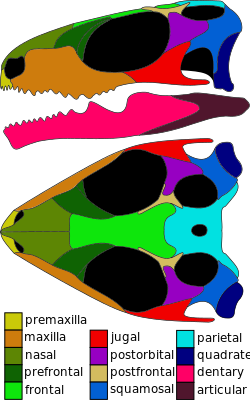Biology:Planocephalosaurus
| Planocephalosaurus | |
|---|---|

| |
| Skull diagram of Planocephalosaurus robinsonae | |
| Scientific classification | |
| Domain: | Eukaryota |
| Kingdom: | Animalia |
| Phylum: | Chordata |
| Class: | Reptilia |
| Order: | Rhynchocephalia |
| Suborder: | Sphenodontia |
| Genus: | †Planocephalosaurus Fraser, 1982[1] |
| Species | |
| |
Planocephalosaurus is an extinct genus of basal rhynchocephalian. Fossils of the genus are primarily known from fissure fill deposits from the Late Triassic of southwest Britain, with fragmentary remains possibly belonging to the genus also known from the Late Triassic of Texas.
Taxonomy
The genus and the type species P. robinsonae was described in 1982 by Fraser from remains found in fissure fill deposits in Gloucestershire in southwest Britain.[1] In 2004, a second species P. lucasi was described from remains found in the Tecovas Formation in Texas.[2] P. robinsonae is known from disarticulated remains covering most of the skeleton,[1][3], while P. lucasi is known from fragments of the jaws.[2][4] While originally classified in Sphenodontidae,[1] later studies have placed it as a basal sphenodontian, more derived than Diphydontosaurus but more basal than Clevosaurus.[5]
Cladogram after:[6]
| ||||||||||||||||||||||||||||||||||||||||||||||||||||||||||||||||||||||||||||||||||||||||||||||
Description
Planocephalosaurus robinsonae was a small sphenodontian, with a skull length of around 2 centimetres (0.79 in),[1] with a total length of around 14.5–16 centimetres (5.7–6.3 in).[3] Unlike the modern tuatara, the skull is thought to lack a complete lower temporal bar connecting the jugal and the quadrate, though a complete temporal bar may have been variably present in some adult individuals.[1] While initially suggested to have had fully acrodont dentition,[1] later X-ray analysis suggested that the teeth at the front of the jaws of Planocephalosaurus were attached to a shelf on the inward side of the jaw, technically making them pleurodont, though they had some characters typically associated with acrodonty, such as having no clear boundary between the teeth and jaw bone. The back of the jaws had enlarged fully acrodont teeth fused to the apex of the jaw bone, similar to Diphydontosaurus.[1][7][8]
Ecology
Planocephalosaurus is thought to have been insectivorous, with it possibly also feeding on small vertebrates.[1]
References
- ↑ 1.0 1.1 1.2 1.3 1.4 1.5 1.6 1.7 1.8 Fraser, N.C. (November 1982). "A New Rhynchocephalian from the British Upper Trias". Palaeontology 25 (4): 709–725. https://www.palass.org/sites/default/files/media/publications/palaeontology/volume_25/vol25_part4_pp709-725.pdf.
- ↑ 2.0 2.1 Heckert, A. B. 2004. Late Triassic microvertebrates from the lower Chinle Group (Otischalkian-Adamanian: Carnian), southwestern U.S.A. New Mexico Museum of Natural History & Science Bulletin 27:1–170.
- ↑ 3.0 3.1 Fraser, N.C.; Walkden, G.M. (August 1984). "The postcranial skeleton of the Upper Triassic sphenodontid Planocephalosaurus robinsonae". Palaeontology 27 (3): 575–595. https://www.palass.org/sites/default/files/media/publications/palaeontology/volume_27/vol27_part3_pp575-595.pdf.
- ↑ Heckert, Andrew B.; Lucas, Spencer G.; Rinehart, Larry F.; Hunt, Adrian P. (July 2008). "A New Genus and Species of Sphenodontian From the Ghost Ranch Coelphysis Quarryu (Upper Triassic: Apachean), Rock Point Formation, New Mexico, USA" (in en). Palaeontology 51 (4): 827–845. doi:10.1111/j.1475-4983.2008.00786.x. ISSN 0031-0239. https://onlinelibrary.wiley.com/doi/10.1111/j.1475-4983.2008.00786.x.
- ↑ Chambi-Trowell, Sofia A. V.; Martinelli, Agustín G.; Whiteside, David I.; Vivar, Paulo R. Romo de; Soares, Marina Bento; Schultz, Cesar L.; Gill, Pamela G.; Benton, Michael J. et al. (2021-06-03). "The diversity of Triassic South American sphenodontians: a new basal form, clevosaurs, and a revision of rhynchocephalian phylogeny" (in en). Journal of Systematic Palaeontology 19 (11): 787–820. doi:10.1080/14772019.2021.1976292. ISSN 1477-2019. https://www.tandfonline.com/doi/full/10.1080/14772019.2021.1976292.
- ↑ Sues, Hans-Dieter; Schoch, Rainer R. (2023-11-07). "The oldest known rhynchocephalian reptile from the Middle Triassic (Ladinian) of Germany and its phylogenetic position among Lepidosauromorpha" (in en). The Anatomical Record. doi:10.1002/ar.25339. ISSN 1932-8486. PMID 37937325. https://anatomypubs.onlinelibrary.wiley.com/doi/10.1002/ar.25339.
- ↑ Fraser, N.C.; Shelton, C.G. (1988). "Studies of tooth impantation in fossil tetrapods using high-resolution X-radiography". Geological Magazine 125 (2): 117–122. doi:10.1017/s0016756800009523. Bibcode: 1988GeoM..125..117F.
- ↑ "A Review of Tooth Implantation Among Rhynchocephalians (Lepidosauria)" (in en). Journal of Herpetology 51 (3): 300–306. September 2017. doi:10.1670/16-146. ISSN 0022-1511.
Wikidata ☰ Q3906278 entry
 |


